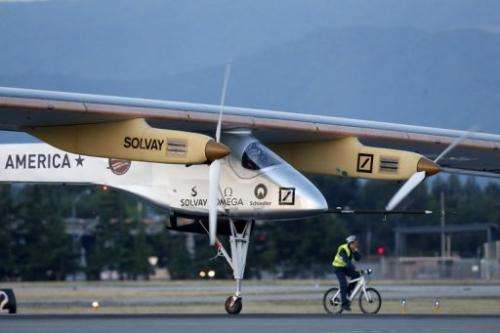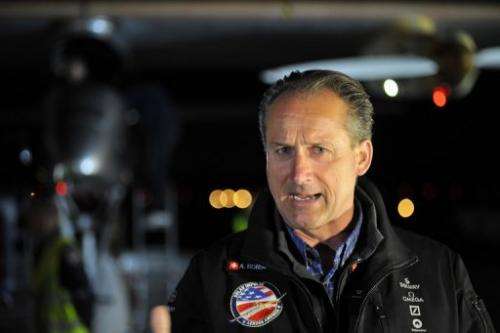Solar plane set for new leg of cross-country US trip

The first-ever manned airplane that can fly by day or night on solar power alone was set to soar early Wednesday on the second leg of its journey across the United States.
The fuel-free Solar Impulse was due to leave Phoenix, Arizona for Dallas, Texas, organizers said. The US crossing is being billed as the plane's first cross-continent flight.
On May 3, Swiss adventurer Bertrand Piccard flew the craft from Moffett Airfield near San Francisco, California to Sky Harbor International Airport in Phoenix on the first leg of the trip.
But Wednesday fellow Swiss adventurer Andre Borschberg will be at the controls flying the craft to Dallas on a 1,337 km (830 mile) journey that would set a world record for distance.
On the first phase of the continental crossing the plane—which has a slim body and four electric engines attached to enormous wings—flew quietly at an average speed of about 30 miles (49 kilometers) per hour.
Energy provided by 12,000 solar cells powered the plane's propellers.
The project aims to showcase what can be accomplished without fossil fuels, and has set its "ultimate goal" as an around-the-world flight in 2015.
The plane can fly at night by reaching a high elevation of 27,000 feet (8,230 meters) and then gently gliding downward, using almost no power through the night until the sun comes up to begin recharging the solar cells.
The US itinerary allows for up to 10 days at each stop in order to showcase the plane's technology to the public. Another stop is planned in the US capital Washington before the trip concludes in New York in early July.
The stopovers will allow Piccard and Borschberg to share duties and rest between flights.
A dashboard showing the live speed, direction, battery status, solar generator and engine power, along with cockpit cameras of both Piccard and his view from the plane, were online at live.solarimpulse.com.

The aircraft completed its first intercontinental journey from Europe to Africa in June on a jaunt from Madrid to Rabat.
The plane completed the first-ever solar 26-hour day and night trip in 2010.
However, the cockpit has room for just one pilot, so even though the plane could likely make the entire US journey in three days, Piccard decided it would be easier to rest and exchange flight control with Borschberg at the stops.
Solar Impulse was launched in 2003.
The slim plane is particularly sensitive to turbulence and has no room for passengers, but Piccard has insisted that those issues are challenges to be met in the future, rather than setbacks.
Sponsors include the Solvay Chemical Group, Omega watches and the Swiss elevator and escalator company, The Schindler Group.
© 2013 AFP





















